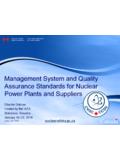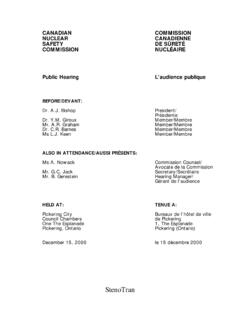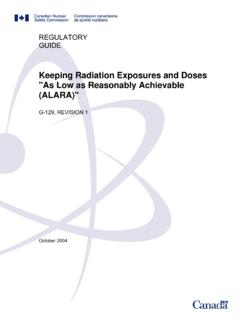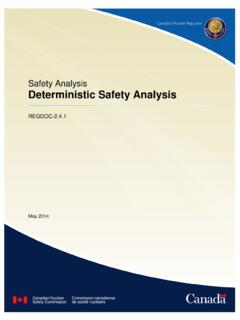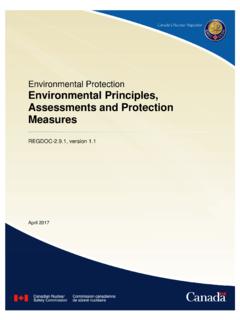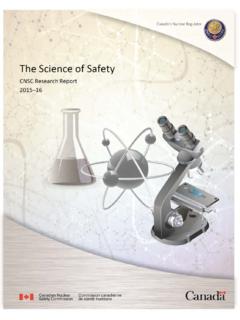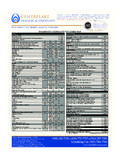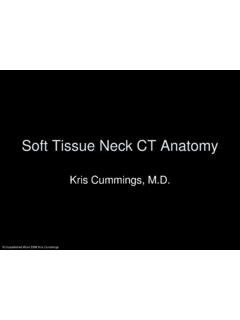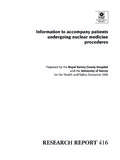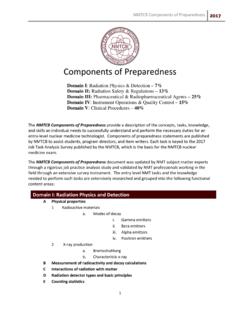Transcription of GD-52 Design Guide for Nuclear Substance …
1 Design Guide for Nuclear Substance laboratories and Nuclear medicine Rooms GD-52 May 2010 Design Guide for Nuclear Substance laboratories and Nuclear medicine Rooms Guidance Document GD-52 Published by the Canadian Nuclear Safety Commission Minister of Public Works and Government Services Canada 2010 Extracts from this document may be reproduced for individual use without permission, provided the source is fully acknowledged. However, reproduction in whole or in part for purposes of resale or redistribution requires prior written permission from the Canadian Nuclear Safety Commission. Catalogue number: CC172-59/2010E-PDF ISBN 978-1-100-15791-7 Ce document est galement disponible en fran ais sous le titre Guide de conception des laboratoires de substances nucl aires et des salles de m decine nucl aire. Document availability This document is available in English and French on the CNSC website at A paper copy of the document in either official language can be ordered from: Canadian Nuclear Safety Commission Box 1046, Station B 280 Slater Street Ottawa, Ontario, CANADA, K1P 5S9 Telephone: 613-995-5894 or 1-800-668-5284 (Canada only) Facsimile: 613-992-2915 E-mail: Publishing History: May 2010 Edition November 2008 Draft edition for Public Consultation Preface This guidance document provides information for a recommended approach for meeting the requirements related to site description and room Design under paragraphs 3(1)(d) and 3(1)(l) of the Nuclear Substances and Radiation Devices Regulations and performing shielding Design analyses as a component of keeping doses As Low As Reasonably Achievable (ALARA) pursuant to paragraph 4(a) of the Radiation Protection Regulations.
2 This guidance document provides Design recommendations for a Nuclear medicine room or a Nuclear Substance laboratory where unsealed Nuclear substances are to be used, and an approach for submitting the proposed Design to the Canadian Nuclear Safety Commission (CNSC). It includes guidance on finishing and fixtures, plumbing, storage, security, ventilation, shielding, and dose estimation for basic, intermediate, high, and containment level Nuclear Substance laboratories and Nuclear medicine rooms. Key principles and elements used in developing this Guide are consistent with national and international standards. The complete list is included in Associated Documents; examples include Laboratory Biosafety Manual from the World Health Organization (WHO); and CSA Fume Hoods and Associated Exhaust Systems from the Canadian Standards Association (CSA). Nothing contained in this document is to be construed as relieving any licensee from pertinent requirements.
3 It is the licensee s responsibility to identify and comply with all applicable regulations and licence conditions. May 2010 GD-52 Design Guide for Nuclear Substance laboratories and Nuclear medicine RoomsContents 1 1 1 Relevant Regulations .. 1 Licensing Process for Nuclear Substance laboratories and Nuclear medicine Rooms .. 2 Using the Design Assessment Form (DAF).. 3 Supplementary Information for Part A of the Design Assessment Form .. 3 Classification of 3 Supplementary Information for Part F of the Design Assessment 5 Dose Estimates for Nuclear medicine Room Design 5 Dose Estimates for Conventional Diagnostic Nuclear medicine A Five-Step 5 Dose Estimates for Positron Emission Tomography (PET) 7 Dose Estimates for In-Patient 131I Therapy Applications.
4 8 Dose Estimates for High and Containment Level laboratories .. 8 Dose Estimates for Nuclear Substance laboratories in Veterinary Nuclear 8 Appendix A Dose Conversion Factors (DCF) and Annual Limits on Intake (ALI) for Common Nuclear Substances .. 9 Appendix B Calculating Dose 13 Sample Calculation for Dose Estimates for Nuclear medicine 13 Conclusion .. 23 Appendix C Design Assessment Form .. 25 A General 27 B Finishing and Fixtures (for use and storage areas) .. 28 C 29 D Security .. 29 E 30 F Shielding/Dose 32 G Miscellaneous .. 32 Glossary .. 33 35 Additional Information .. 37 i May 2010 GD-52 Design Guide for Nuclear Substance laboratories and Nuclear medicine Rooms ii May 2010 GD-52 Design Guide for Nuclear Substance laboratories and Nuclear medicine RoomsGD-52 Design Guide for Nuclear Substance laboratories and Nuclear medicine Rooms Introduction Purpose This guidance document provides information for a
5 Recommended approach for meeting the requirements related to site description and room Design under paragraphs 3(1)(d) and 3(1)(l) of the Nuclear Substances and Radiation Devices Regulations and performing shielding Design analyses as a component of keeping doses As Low As Reasonably Achievable (ALARA) pursuant to paragraph 4(a) of the Radiation Protection Regulations. Scope This guidance document provides Design recommendations for a Nuclear medicine room or a Nuclear Substance laboratory where unsealed Nuclear substances are to be used, and an approach for submitting the proposed Design to the Canadian Nuclear Safety Commission (CNSC). It includes guidance on finishing and fixtures, plumbing, storage, security, ventilation, shielding, and dose estimation for basic, intermediate, high, and containment level Nuclear Substance laboratories and Nuclear medicine rooms. Relevant Regulations The provisions of the Nuclear Safety and Control Act (NSCA) and the regulations made under the NSCA relevant to this Guide are as follows: 1.
6 Subsection 24(4) of the NSCA states that No licence may be issued, renewed, amended or replaced unless, in the opinion of the Commission, the applicant (a) is qualified to carry on the activity that the licence will authorize the licensee to carry on; and (b) will, in carrying on that activity, make adequate provision for the protection of the environment, the health and safety of persons and the maintenance of national security and measures required to implement international obligations to which Canada has agreed. 2. Section 3 of the General Nuclear Safety and Control Regulations provides a list of information which an application for a licence shall contain. 3. Paragraph 12(1)(c) of the General Nuclear Safety and Control Regulations states that Every licensee shall take all reasonable precautions to protect the environment and the health and safety of persons and to maintain security. 4. Paragraph 3(1)(d) of the Nuclear Substances and Radiation Devices Regulations states that An application for a licence in respect of a Nuclear Substance or a radiation device, other than a licence to service a radiation device, shall (d) the proposed location of the activity to be licensed, including a description of the site.
7 1 May 2010 GD-52 Design Guide for Nuclear Substance laboratories and Nuclear medicine Rooms5. Paragraph 3(1)(l) of the Nuclear Substances and Radiation Devices Regulations states that An application for a licence in respect of a Nuclear Substance or a radiation device, other than a licence to service a radiation device, shall contain, where the application is in respect of a Nuclear Substance that is an unsealed source and that is to be used in a room, the proposed Design of the room. 6. Subparagraph 4(a)(iii) of the Radiation Protection Regulations states that Every licensee shall implement a radiation protection program and shall, as part of that program, (a) keep the amount of exposure to radon progeny and the effective dose and equivalent dose received by and committed to persons as low as is reasonably achievable, social and economic factors being taken into account, through the implementation (iii) control of occupational and public exposure to radiation.
8 Licensing Process for Nuclear Substance laboratories and Nuclear medicine Rooms As part of the process to obtain a licence for the use of an unsealed Nuclear Substance , applicants must submit a completed licence application in accordance with section 3 of the General Nuclear Safety and Control Regulations, section 3 of the Nuclear Substances and Radiation Devices Regulations, and section 4 of the Radiation Protection Regulations. As part of the licence application, applicants must submit the proposed Design of the room in which unsealed Nuclear substances will be used. The Design Assessment Form (DAF) provided in Appendix C of this document assists licence applicants with the submission of the proposed Design of their Nuclear medicine room or Nuclear Substance laboratory. A DAF should be completed for any new construction or major renovation (such as demolishing walls, changes to existing shielding, or installing new fumehoods; for additional information, contact a CNSC Licensing Specialist) and enclosed with the new application or a request for amendment.
9 A good laboratory Design facilitates adherence to safe policies and procedures. The completed DAF should be submitted to the CNSC as early as possible in the Design stage in order to facilitate the processing of the licence application or amendment. If multiple rooms are to be constructed or renovated and are to be of similar Design and function, only one DAF needs to be submitted. Where more than one laboratory or room for the handling of unsealed sources is to be constructed or renovated, and the designation or use of each is different, a separate DAF should be submitted for each laboratory or room. CNSC staff may request additional information after the initial Design or renovation assessment is complete. 2 May 2010 GD-52 Design Guide for Nuclear Substance laboratories and Nuclear medicine Using the Design Assessment Form (DAF) The DAF is divided into the following categories: A General Information; B Finishing and Fixtures; C Plumbing; D Security; E Ventilation; F Shielding/Dose Control; and G Miscellaneous.
10 The guidelines set out in the DAF are considered to be good Design features that contribute to the optimization of radiation protection and keeping doses ALARA. The plans for the Design , construction, or renovation of all Nuclear Substance laboratories and Nuclear medicine rooms should incorporate the guidelines applicable to the work to be performed. Any proposed variation from the guidelines should be supported by additional information to demonstrate, to the satisfaction of CNSC staff, that the guideline is not applicable due to the nature of the proposed activities, or that the guideline is addressed by alternative measures that provide an equivalent degree of safety. Supplementary Information for Part A of the Design Assessment Form Classification of Rooms Part A of the DAF asks for general information, including the classification of the room in which the Nuclear Substance will be used. Rooms where unsealed Nuclear substances are used in industrial, medical, or academic research settings are classified by the CNSC as basic, intermediate, high, or containment-level laboratories , or as Nuclear medicine rooms, depending on the amount of Nuclear substances handled in the room and on the nature of the work performed.
